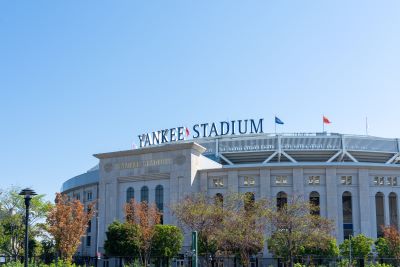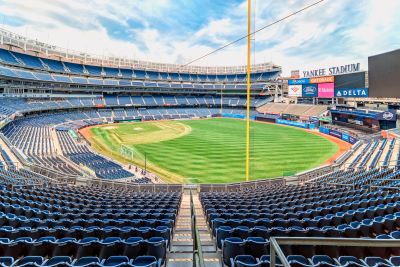Love ’em or hate ’em, the New York Yankees will be battling for Major League Baseball’s (MLB) 2024 World Series championship title against the Los Angeles Dodgers. The series will take place at the two teams’ home stadiums, and although all eyes will be on the baseball players, the facilities will also play a critical role during the big games.
The World Series starts October 25 and could run through to November 2, with the home-field advantage determined by the team that had the highest winning percentage during the regular season. The Dodgers with 98 wins and 64 losses beat out the Yankees with 94 wins and 68 losses.
As a result, games 1 and 2, (and 6 and 7, if necessary) of the World Series will be played at Dodger Stadium October 25 and 26, (and November 1 and 2, if necessary). Games 3 and 4, (and 5, if necessary), of the World Series will be played at Yankee Stadium.
In this profile, Facilities Management Advisor takes a look at Yankee Stadium and provides key stats.

Whether you watch the games from a stadium seat or see all the action from the comfort of your home, you’ll likely be cheering on your favorite baseball team to be crowned the 2024 World Series Champions.
While the players on the field are where the action is, facilities professionals worldwide will be focused on one of the show’s other stars: Yankee Stadium.
What You Need to Know
- Name: Yankee Stadium
- Location: Bronx, New York
- Owner: New York City Industrial Development Agency (NYCIDA)
- Cost to build: $2.3 billion; adjusted for inflation it cost $3.6 billion making it the most expensive MLB stadium.
- Seating capacity: It currently has 46,537 seats but can accommodate up to 52,325 with fans standing.
- Size (total area): 1,350,000 square feet (sq. ft.)
- Levels: 4
- Interesting tidbit: The original Yankee Stadium, one block south of this stadium, was built in 1923 with 58,000 seats (but sometimes had as many as 70,000 guests) and was demolished in 2008. It was home to various other events including boxing matches, college football, professional football, soccer, concerts, and religious events. This site is now a 10-acre public park called Heritage Field with three youth sandlot diamonds, a track, and a soccer field.
- Key building materials: The new Yankee Stadium field and main concourses were constructed with concrete and the rest of the stadium was framed with 12,000 tons of steel.
- Notable features: An iconic façade (also called frieze), made of limestone and granite, along the roof of the grandstand which encircles the new Yankee Stadium’s upper levels. It calls back to the 1923 stadium whose frieze was a defining feature of the stadium’s silhouette.
- Year opened: 2009
- Renovations: 2016, 2020, 2024
- Primary uses: Yankees (2009–present), National Collegiate Athletic Association (NCAA) college football Pinstripe Bowl (2010–present), New York City Football Club (NYCFC) Major League Soccer (MLS) (2015–present).
- Secondary uses: Events held at Yankee Stadium include concerts, banquets, awards dinners, corporate events and conferences, fundraisers, trade shows, press conferences, weddings, receptions, bar/bat mitzvahs, barbeques, picnics, birthday parties, and holiday parties.
Renovations
Yankees Clubhouse
In spring 2024, a video tour of the newly renovated Yankees Clubhouse was made public. The clubhouse includes a long glass case that displays the team’s World Series rings, a workout room, a weight room, a dining area called “The Pinstripe Diner,” pools and ice baths, a sauna, and an oxygen tank.
Social gathering areas

In 2020, two new social gathering areas in Yankee Stadium were established called The Stella Artois Landing and Michelob ULTRA Clubhouse. The Stella Artois Landing spans sections 232A and 232B, in the left field, and the Michelob ULTRA Clubhouse spans sections 207 and 208, in the right field.
These areas are accessible to fans with game-day tickets anywhere in the stadium and are available as pregame party spaces for groups of 20 or more people.
At the time of these renovations, Yankees Senior Vice President of Strategic Ventures Marty Greenspun, said, “We are excited to have fans experience these newly constructed areas, which are part of the continuing, large-scale initiative to transform the fan experience at Yankee Stadium that began prior to the 2017 season.”
Kids Clubhouse
In Spring 2017, a 2,850 sq. ft. Kids Clubhouse opened in Yankee Stadium behind the right field upper deck seats featuring Yankees-themed playground equipment, a 6-foot-high replica World Series trophy, retractable shades, and a private space for nursing mothers.
“I wanted to create a space where parents could sit down in the shade, be able to watch the game on TV, and allow their kids to play in a safe, contained space,” said Yankees owner Hal Steinbrenner.
Features
Monument Park
Features a display with all the New York Yankees’ retired uniform numbers, as well as commemorative plaques for key players, managers, and events at Yankee Stadium. It is located on the field level section 36, between the bullpens and adjacent to the loading dock.
Yankee Stadium Museum Presented by Bank of America
This 3,600 sq. ft. space features rotating exhibits centered on Yankee Stadium as well as permanent museum fixtures that include seven Commissioner’s Trophies commemorating Yankees’ World Series championships between 1977 and 2009. The museum can host up to 80 people for seated dinners and up to 125 people for cocktail receptions.
Premium Seating
Options include:
- Legends Suite: Features first-class accommodations with all-inclusive food and nonalcoholic beverages as well as fine dining with performance-cooking stations, with views of the playing field behind home plate. Other amenities include private restrooms, cushioned suite seats, in-seat wait service, private stadium entrance, and complimentary preferred parking. From there, fans can also access the two-level 9,472 sq. ft. Legends Suite Club, Cutwater Lounge, and DraftKings Sportsbook Lounge.
- Champions Suite: With seats located beyond the first and third base, this suite has access to an all-inclusive food and nonalcoholic beverages. It features cushioned suite seats as well as in-seat wait service, personal side tables next to select seats, and complimentary preferred parking. It has access to Cutwater Lounge and DraftKings.
- Delta SKY360 Suite: With expansive views of the playing field from the main level, guests have access to fine dining options. Complimentary snacks and nonalcoholic beverages are provided as well as private restrooms. Other amenities include cushioned suite seats, in-seat wait service, and complimentary preferred parking.
- Ford Field MVP Club: With a view between the bases on the field level, guests can enjoy cushioned seats and in-seat wait service. Season ticket licensees can get complimentary snacks and nonalcoholic beverages as well as complimentary preferred parking.
- Jim Beam Club: Season ticket licenses get exclusive access to the Jim Beam Club Lounge with private restrooms. The club has complimentary snacks, fountain soda refills, and cushioned seats.
Sustainability
Being a good neighbor to the environment is one of management’s goals at Yankee Stadium.
In fact, in 2019, the New York Yankees became the first major North American sports team to be part of the United Nations (UN) Sports for Climate Action Framework. Their goal is to be a role model for other stadiums in helping to bring greenhouse emissions in line with the Paris Climate Change Agreement.
“The New York Yankees are proud to support the United Nations Sports for Climate Action Framework,” said Steinbrenner.
“For many years the Yankees have been implementing the type of climate action now enshrined in the Sports for Climate Action principles, and with this pledge, the Yankees commit to continue to work collaboratively with our sponsors, fans, and other relevant stakeholders to implement the UN’s climate action agenda in sports.”
To meet these goals, the Yankees have done the following:
- Converted to high-efficiency light-emitting diodes (LED) lighting: Yankee Stadium became the second MLB stadium to use LED field lighting. These are 40% more efficient and 50% brighter than previous field lighting.
- Energy efficient technologies and design: The 31,000 sq. ft. Great Hall at Yankee Stadium is the largest open-air public entry of any sports venue worldwide using natural cooling and ventilation. It can also be used to seat 800 for dinners and have up to 1,500 for receptions. The Stadium’s interior uses automation technologies that identify and eliminate wasted energy use, which look at usage patterns and reduce lighting and ventilation systems when they aren’t needed.
- Offset unavoidable greenhouse gas (GHG) emissions: In collaboration with The South Pole Group, the Yankees monitor stadium energy use, team and employee travel, motors that require fossil fuel use, non-recyclable waste generation, and occasional leaks of refrigerants.
- Yankee Stadium Tower Garden: In partnership with Tower Farms and the Green Bronx Machine, the Tower Garden at Yankee Stadium began in 2022 using a vertical, aeroponic garden system to grow fresh produce like lettuce and herbs. Items are served to fans in select menus such as salads at the stadium’s “grab and go” locations.
- Public transportation: Located near stops for the Metropolitan Transit Authority (MTA) subway, Metro-North Railroad, buses, and other mass transportation systems, Yankee Stadium has better access to mass transit than any other MLB stadium. They also have high-capacity bike-sharing stations at three locations around the stadium.
- Composting and recycling: Yankee Stadium uses compostable cutlery and food-service packaging, trays, boxes, plates, and cups are used instead of non-compostable petroleum-based plastics. Food waste is composted. Cardboard, glass, metal, plastics, and paper are recycled.
- Recovery of waste cooking oil: More than 20,000 gallons of cooking oil from the stadium are recovered and recycled, which is used to produce more than 18,600 gallons of biodiesel fuel, reducing carbon by more than 30,000 pounds.
- Water conservation: Yankee Stadium saves more than 3 million gallons of water each year, through high-efficiency plumbing fixtures, reducing water usage by 22%.
- Healthy air quality: High-performance filters and a regular replacement program result in particle removal effectiveness of Minimum Efficiency Reporting Value (MERV) 13 or greater, which leads to better quality and energy efficiency in the heating, ventilation, and air conditioning (HVAC) system.
- Smart construction: Structural steel used in the construction of Yankee Stadium was fabricated from recycled material. The concrete forms were reusable. Used recycled concrete aggregate was incorporated into the concrete design mix. All construction vehicles and equipment were required to use low-sulfur fuel. 75 percent of construction waste was diverted from landfills.
Security
Yankee Stadium has several security policies and procedures in place to ensure the safety of everyone.
Metal Detectors
As is the case with all 30 MLB parks, and most other venues in today’s environment, all visitors must be screened via metal detectors. As a result, visitors are strongly encouraged to “budget extra time for arrival and entry to Yankee Stadium for all events.”
Bag Policy
Guests are only allowed to bring in soft-sided bags no larger than 16” by 16” by 8” and one smaller-sized soft-sided personal item such as a handbag, clutch, tote, or plastic grocery bag.
Prohibited Items
Banners, flags, posters, apparel, headwear, footwear, and adornments that management believes might lead to or encourage controversy, be offensive, threatening, or intimidating toward others are not allowed.
Additionally, cans, thermoses, glass, and aluminum bottles are prohibited along with professional camera equipment and video and audio recording equipment.
Only single-frame flash photography and extended-length zoom lenses are allowed, which don’t interfere with games or other guests.
Guests can only bring in food for “individual consumption,” and items “such as apples and oranges must be sliced or sectioned,” according to the security policy. Clear factory-sealed plastic bottles of water, 1 liter in size or smaller, are also permitted.
A Facility That’s a Home Run
Whether it’s Yankees Clubhouse, social gathering areas, Kids Clubhouse, Monument Park, Yankee Stadium Museum, the stadium’s sustainability practices, or premium seating, Yankee Stadium is a one-of-a-kind facility that’s proud to co-host the World Series in 2024 with Dodger Stadium in this coast-to-coast matchup that’s sure to excite fans.
